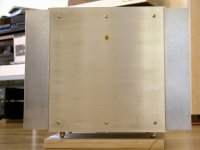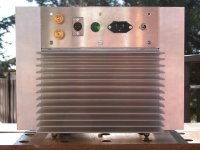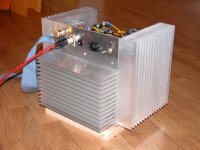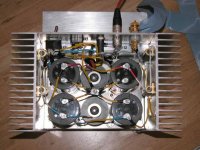Dear Passophiles,
here is my brand new SOZ. This is my first amplifier. It has been lots of fun to build it, but quite hard from the mechanical point of
view. I work not far from Cinecitta' in Rome and I was lucky to met an harley biker whose job is to rebuild mechanical parts for broken cinematographic cameras. He helped me a lot with aluminium. Sometimes diy building helps you to make nice friends!
My design goal was a compact unit (to increase WAF) and as you can see I fitted inside a "small" box a 600 VA transformer and big
47,000 uF caps. Total weight should be over 20 kg. Caps and heatsinks are surplus stuff which put some constraints on the box design. Active devices are matched IRFP044 and power resistors are Dale RH series. I used 10 awg teflon copper wire for the power unit and 12 awg solid silver copper wire for the signal path.
The input voltage is around 23 V for about 10 W output.
The amps run quite hot, I did not measure them yet but they should be around 60 deg C. The measured DC offset is few tens of millivolts for both channels. The amps are not totally silent, but it is not bad for such a compact design. Probably I have to check the inductors, located just above the big toroid in the present layout.
Ah the sound... both rich and natural, full and detailed, and very live and dynamic!! They are wonderful partners for my diy speakers (TQWP with Fostex Fe103Z).
I wish to thank Mr Pass for his support to the DIY community
and all the forum members for so many hints and tips...
Carlo
here is my brand new SOZ. This is my first amplifier. It has been lots of fun to build it, but quite hard from the mechanical point of
view. I work not far from Cinecitta' in Rome and I was lucky to met an harley biker whose job is to rebuild mechanical parts for broken cinematographic cameras. He helped me a lot with aluminium. Sometimes diy building helps you to make nice friends!
My design goal was a compact unit (to increase WAF) and as you can see I fitted inside a "small" box a 600 VA transformer and big
47,000 uF caps. Total weight should be over 20 kg. Caps and heatsinks are surplus stuff which put some constraints on the box design. Active devices are matched IRFP044 and power resistors are Dale RH series. I used 10 awg teflon copper wire for the power unit and 12 awg solid silver copper wire for the signal path.
The input voltage is around 23 V for about 10 W output.
The amps run quite hot, I did not measure them yet but they should be around 60 deg C. The measured DC offset is few tens of millivolts for both channels. The amps are not totally silent, but it is not bad for such a compact design. Probably I have to check the inductors, located just above the big toroid in the present layout.
Ah the sound... both rich and natural, full and detailed, and very live and dynamic!! They are wonderful partners for my diy speakers (TQWP with Fostex Fe103Z).
I wish to thank Mr Pass for his support to the DIY community
and all the forum members for so many hints and tips...
Carlo
Attachments
nice looking amp!!
what is the output power / rail volts?
Did you use 50W or 100W resistors?
For the size of the big cans, I bet they are 100V rated or very old.
I would try newer/smaller one just to check sound quality.
I bought some 150000uF panasonic big cans real cheap and I'm feel that some high quality 47000uF are better then this babies.
I will use them in a 15W SOZ that I'm building.
what is the output power / rail volts?
Did you use 50W or 100W resistors?
For the size of the big cans, I bet they are 100V rated or very old.
I would try newer/smaller one just to check sound quality.
I bought some 150000uF panasonic big cans real cheap and I'm feel that some high quality 47000uF are better then this babies.
I will use them in a 15W SOZ that I'm building.
are the 1ohm resistors on the front heat sink with
the MOSFETS? ...cause i don't see them 🙂
wow, looks great for a 1st amp...
i'm patiently waiting for my heat sinks so that
i can attempt my SOZ
moe29
the MOSFETS? ...cause i don't see them 🙂
wow, looks great for a 1st amp...
i'm patiently waiting for my heat sinks so that
i can attempt my SOZ
moe29
What kind of speaker Cables are those?
It looks like 80 pin SCSI cable... arent those usually just tinned copper? How do they sound, are the pairs twisted?
-Paul
It looks like 80 pin SCSI cable... arent those usually just tinned copper? How do they sound, are the pairs twisted?
-Paul
Great Work & Pictures - cjunk
You should publish them at PassDiy.com
😎 In his Gallery! 😎
Pass D.I.Y. Gallery of DIY projects
Along with the other Son Of Zens
It is there such nice pictures belong, for Sure!
-----------------------------------------------------
/halo - enjoys these fantastic constructions
You should publish them at PassDiy.com
😎 In his Gallery! 😎
Pass D.I.Y. Gallery of DIY projects
Along with the other Son Of Zens
It is there such nice pictures belong, for Sure!
-----------------------------------------------------
/halo - enjoys these fantastic constructions
...i hope that's not a yellow LED on the front panel...
i'm afraid your highs will be etched and your lows tubby,
with an all around dryness/dark/bright causal effect...
a Blue LED will clear all this up though
moe29
--------
the Blue Led enforcer
😱
(still a great looking amp though!)
i'm afraid your highs will be etched and your lows tubby,
with an all around dryness/dark/bright causal effect...
a Blue LED will clear all this up though
moe29
--------
the Blue Led enforcer
😱
(still a great looking amp though!)
Replace yellow led
Congratulation another very interesting design and good made chasis. But I'll replace the yellow led with BLUE one 🙂 This is just mine opinion.
best regards,
LEON
Congratulation another very interesting design and good made chasis. But I'll replace the yellow led with BLUE one 🙂 This is just mine opinion.
best regards,
LEON
The importance of LED - regarding sound caracter
We all know by discussion, the importance of Wire Colors!
Follow up to cap sleeve thread,Wire color makes a diffrence!!
--------------------------------------
But also what solder you use & and of course the frontLED
will heavily effect the Sound of any amplifier in a substancial
and very noticeable way.
This is a well establish fact through serious listening research by
some of worlds "most golden ears".
Can not be ignored!!!
The frontal/center sounds will be most affected
by this LED - many poor guys live with bad "upfront sounds".
Thanks moe29, for pointing this out to this obvious newcomer
- who is happily unknowing of this defect of this otherwise interesting amplifier.
/halo - mixes his LEDs for the ultimate sound performance 😎
Yes, That is true!moe29 said:...i hope that's not a yellow LED on the front panel...
i'm afraid your highs will be etched and your lows tubby,
with an all around dryness/dark/bright causal effect...
a Blue LED will clear all this up though
moe29
--------
the Blue Led enforcer
😱
(still a great looking amp though!)
We all know by discussion, the importance of Wire Colors!
Follow up to cap sleeve thread,Wire color makes a diffrence!!
--------------------------------------
But also what solder you use & and of course the frontLED
will heavily effect the Sound of any amplifier in a substancial
and very noticeable way.
This is a well establish fact through serious listening research by
some of worlds "most golden ears".
Can not be ignored!!!

The frontal/center sounds will be most affected
by this LED - many poor guys live with bad "upfront sounds".
Thanks moe29, for pointing this out to this obvious newcomer
- who is happily unknowing of this defect of this otherwise interesting amplifier.
/halo - mixes his LEDs for the ultimate sound performance 😎
Very Fine. And I hope to have mine up here in another month!!!
er..... about that LED, blue is the Pass Labs color, if you know what I mean- a nudge is a good as a wink, eh? eh?
We're just teasing you! 😉
er..... about that LED, blue is the Pass Labs color, if you know what I mean- a nudge is a good as a wink, eh? eh?
We're just teasing you! 😉
moe29 said:...i hope that's not a yellow LED on the front panel...
i'm afraid your highs will be etched and your lows tubby,
with an all around dryness/dark/bright causal effect...
a Blue LED will clear all this up though
moe29
--------
the Blue Led enforcer
😱
(still a great looking amp though!)
Haha, will any blue led do ? 😉
Great!
Very nice work, also the metal work is notable.
should you send me an e-mail with some info about where did you find the metals? thank you!
my e-mail: fdalpasso@cu.mi.it
bye, Fabrizio
Very nice work, also the metal work is notable.
should you send me an e-mail with some info about where did you find the metals? thank you!
my e-mail: fdalpasso@cu.mi.it
bye, Fabrizio
PedroPO said:nice looking amp!!
what is the output power / rail volts?
Did you use 50W or 100W resistors?
For the size of the big cans, I bet they are 100V rated or very old.
I would try newer/smaller one just to check sound quality.
I bought some 150000uF panasonic big cans real cheap and I'm feel that some high quality 47000uF are better then this babies.
I will use them in a 15W SOZ that I'm building.
Rail volts are 23 V, the tranformer secondaries are 20 V.
I used 50 W resistors for the 8 Ohm value and 25 W for the 1 Ohm.
You are right, caps are 100V rated, I will try also newer (and may be better) caps. These big caps come from a surplus store and they were very cheap.
Carlo
moe29 said:...i hope that's not a yellow LED on the front panel...
I am sorry but it is not a led, but a neon indicator (230 V, farnell order code 140-001).
Unfortunately it is only avalaible in red, green, amber and clear, but not BLUE!!! ...mine is amber...
Carlo
Re: What kind of speaker Cables are those?
Sorry I do not know which kind of cable it is, but I do not think it is a scsi cable.
Conductors are stranded silver copper wires, not twisted. It sounds very transparent and also very similar to cat5 that I am using now.
PaulHilgeman said:It looks like 80 pin SCSI cable... arent those usually just tinned copper? How do they sound, are the pairs twisted?
-Paul
Sorry I do not know which kind of cable it is, but I do not think it is a scsi cable.
Conductors are stranded silver copper wires, not twisted. It sounds very transparent and also very similar to cat5 that I am using now.
- Status
- Not open for further replies.
- Home
- Amplifiers
- Pass Labs
- New SOZ with pictures!




